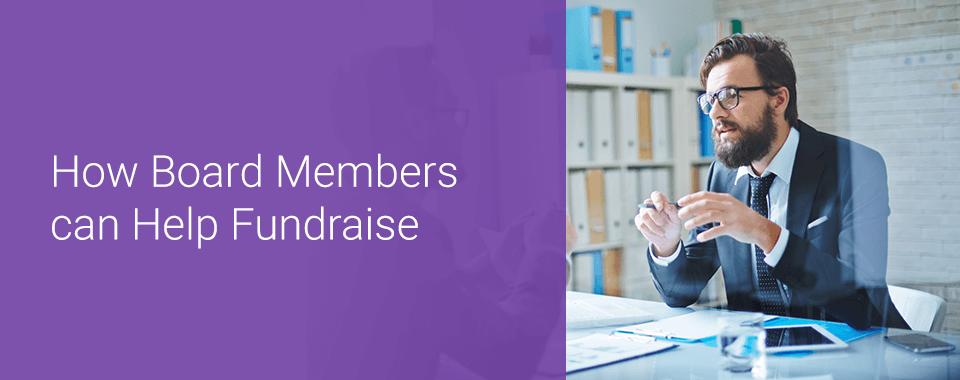Dec 14, 2021
How Board Members Can Help Fundraise

Whether the business is profit or nonprofit, members of its board of trustees have a lot of responsibility. They may govern the organization itself, set new policies, and make sure everything is on track in order to reach the organization’s goals.
In order to meet those goals, a nonprofit organization needs funding, which is why the responsibility of fundraising also falls onto its board members. However, successfully raising money for an organization can be difficult, especially for those with little prior experience in fundraising. Today, you’ll learn the dos and don’ts of proper board fundraising as well as what GiveSmart can do to help you meet your goals.
The Expectations of Board Members in Fundraising
Fundraising is an important part of running a nonprofit organization. It helps ensure that your organization has the resources it needs to carry out its mission, whatever that may be. Board members, when properly trained, can make excellent fundraisers due to their understanding of the organization and their sincere motivations.
However, the board as a whole isn’t necessarily working as one to do the fundraising. It comes down to the individual members and what they’re able to contribute, which means that it’s important to have clear expectations set. With set fundraising expectations, you’ll have a solid background to point out falling numbers.
Here’s how to set up expectations that your board members will be able to meet:
- Set job descriptions: When you have an open board seat, give it a formal job title and outline a set of expectations that come with the position. This means that any potential applicants will know exactly what to expect — not just when it comes to fundraising, but for other responsibilities and donor obligations as well.
- Discuss expectations early: When interviewing potential candidates, be sure to outline and reiterate any expectations you have for them. This way, you can be absolutely sure that your candidate knows what will be expected of them.
- Have a signed agreement: Create an agreement for the new board member to sign that describes what’s expected of them. This can include any fundraising expectations and will give you a concrete way to measure their performance.
- Review expectations: Go over your fundraising expectations at board meetings when you can. Discuss current efforts and allow other members to give feedback and ask for advice.
If you follow these steps, there should be no doubt among your board members about what’s expected of them.
Tips for Board Member Fundraising
Now that you have your expectations set, it’s time to begin your fundraising campaign. However, you may be wondering where to start, or have an idea where to start but be unsure of the finer details. If so, here are a few tips to help your board members raise funds with ease.
Board Training
Making sure your board members are properly trained for fundraising is the first step in a successful campaign. Teach new board members about various fundraising strategies, using past examples if possible. Pick up some books on fundraising programs and give them to your board members to read. If you have access to any online training courses, have the board take them to build their skills. Most importantly, make sure they understand the four roles of a board member in fundraising:
- Leaders: First and foremost, your board leads the organization. They decide what paths your organization takes — whether it pursues growth or stability. These decisions determine how much funding will be needed.
- Ambassadors: In order to raise money for your organization, you need to be connected to as many potential donors as you can. Board members help forge the links between your organization and these potential donors. Once you have these links, you can then cultivate the connection.
- Supporters: Board members should support fundraising ventures wherever possible, whether by attending events, meeting donors, arranging thank-you calls or emails, or whatever else is necessary. Fundraising is about more than speculative practice — it’s about actively pursuing leads and doing what you can to convince others that you’re worth the money.
- Donors: As the board of a nonprofit organization, it’s good to lead by example. Therefore, each board member should be donating yearly to the organization.
Case Statement
People generally prefer to donate when they know that their money will be used responsibly. Crafting a case statement for your nonprofit organization is a good way to show people you’re trustworthy. A good case statement should outline the goals of the organization, how they’re being achieved, and how the donation will help meet these goals.
Toolkit
Keeping up with a fundraising campaign can be difficult. There are several tools you can utilize to help keep the details of your campaign organized:
- Fundraising software: This depends on the type of fundraising you plan to do, but basically, this is any technology you’ll need to carry out your fundraiser. There’s general fundraiser software, as well as specific software for specific events. For example, GiveSmart offers industry-leading software for silent auctions and other events.
- Communication tools: Allows your board members to stay in touch between meetings and discuss your progress.
- Goal tracking: This will allow you to keep track of your current fundraising goals and how close you are to achieving them.
- Donor database: A good donor database will help you manage your current donors, keep track of potential new ones, and show you the last time you interacted with either.
Reach Out
A good fundraising campaign depends on visibility. Reach out to local businesses in your area and see if they’d consider making a donation. They may have less money to give than a national business, but if they’re willing to donate, obtaining it can be as simple as a phone call or a lunch meeting. Utilize social media to make your organization visible on a wider scale and advertise any fundraising events you hold.
The Don’ts of Board Member Fundraising
Even with so many solid do’s for fundraising, you maybe be wondering what things you shouldn’t do if you want your campaign to be successful. Here are a few fundraising don’ts:
- Don’t put your board members on the spot: It’s true that your board members may have connections to wealthy or influential people who would be willing to donate to your organization. It’s also true that they might be able to get you in touch with these people. However, that doesn’t mean you should put them on the spot by asking for names during meetings. Instead, ask them politely and privately if they can arrange a meeting between you and the potential donor.
- Don’t assume skill levels: Even if your board members have prior experience serving on boards, that doesn’t necessarily mean they’re skilled fundraisers. Make sure to include basic fundraising training along with any advanced training, and make sure you and the other board members are on the same page about procedures. If they’re still learning, consider giving them easier tasks to carry out until they’ve learned the ropes.
- Don’t be cryptic or overly aggressive: Clear instructions are easier to follow than vague ones, and demanding results will most likely stress out your board members and lower productivity. Be clear, concise, and understanding.
Learn More about GiveSmart Today
A board member’s position is a busy one, and ensuring successful fundraising is only one task on a list of many. That doesn’t make it any less important, however. Securing proper funding is crucial to keep nonprofit organizations going. Even after learning our do’s and don’ts, you might not be confident you’re up to the task.
If you’re still unsure of your board’s fundraising capabilities, consider GiveSmart. Our silent auction and event fundraising software has helped us raise more than two billion dollars in funding over the past seven years. With our services, you’ll be able to secure the funding your nonprofit needs to stay running. If you’re interested in our support, contact us today and let us help you achieve your goals.
Related



